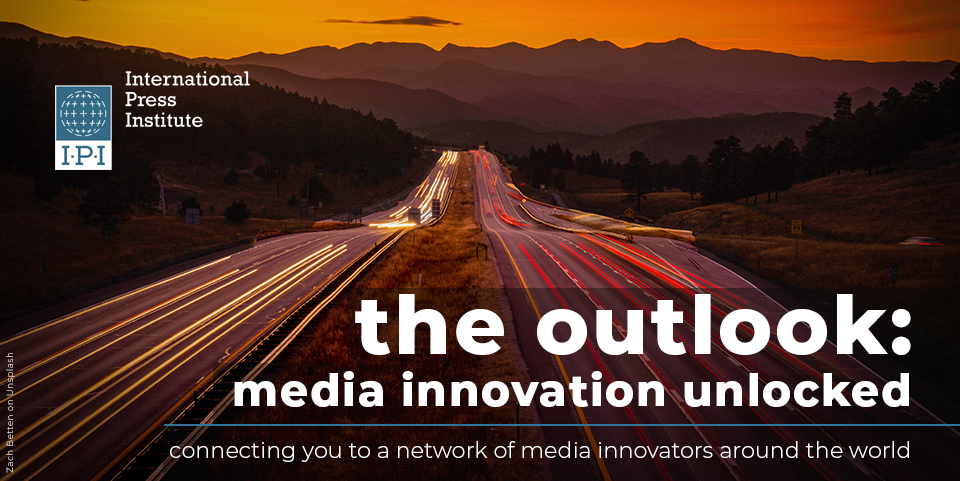This text comes from IPI’s newsletter The Outlook. Click here to sign up to receive future editions direct to your inbox.
This is The Outlook, IPI’s media innovation newsletter, where we take a look at strategies and tools for innovation and business development, and learn from newsrooms that are implementing them.
In this week’s newsletter, we give you a recap and the main highlights of the Media Innovation Festival 2024.

Around 400 leading journalists, editors, and publishers from around the world gathered in Sarajevo for the IPI World Congress and Media Innovation Festival 2024, from 22 to 24 May.
The conference hosted a series of engaging panels, designed to address the most pressing challenges and opportunities in the media landscape. We captured some of the key media innovation learnings and other resources to put you up to speed.
Here is what we have learned from the panels:
Good journalism doesn’t mean good money
- A key idea was that “Good journalism doesn’t mean good money. People need to have a business model.”
- Have dedicated teams with constant communication between the editorial and commercial departments.
- Independence is of the essence, and some offers from funders and advertisers will have to be refused.
- Don’t reinvent the wheel. It’s okay to borrow (and share) successful business strategies from other media.
>> Read more: Investigative journalism needs to solve its business model
Innovate to grow
- Create a setting where “journalists are empowered to do their job, but also open their minds”.
- Innovate to grow: rethinking and strategize is key.
- “Flexibility and persistence” and being fast in acknowledging the crisis are must-have attitudes.
- Taking control and ownership of stories that serve your communities, despite the perceived lack of control.
The panel: Daraj Media, Lebanon; Denník N, Slovakia; Rappler, The Philippines; The Kyiv Independent, Ukraine; Rise News Uganda Network, Uganda.
>> Read more: In a crisis, innovation requires constant readiness and action
Listen to your community
- Harness the power of private messages. “People believe more in what their friends send them”.
- Explore the benefits of content creation and its unique audience engagement.
- Bring young people on board. Have people on your team that are in touch with the realities of that community.
- Embrace honesty and humility while interpreting your audience’s data.
- Let go of preconceptions. Combine audience feedback with data to generate powerful insights.
The panel: UNESCO; ABO Local Media Development Agency, Ukraine; RTV Slon, Bosnia and Herzegovina; Portal Ul-info, Montenegro; Agencia Mural, Brazil; Nakypilo Mediagroup, Ukraine.
>> Read more: How media organizations are serving their audiences first
Move the conversation
- Challenge the narratives of women’s stories that “are either sob stories or that you have to do something challenging to get coverage, like climb the Everest.”
- Focus on building loyalty, instead of educating or convincing the people who are against women’s rights.
- Emphasize intersectionality, both through your stories and your organization’s values.
- Be creative with the revenue sources and tailor funding for specific projects.
- Move the conversation to the structural approaches.
The panel: Agência Mural, Brazil; Alharaca, El Salvador; Africa Women Journalism Project; Women Forum Prijepolje, Serbia; Boju Bajai, Nepal.
>> Read more: A feminist lens should be the default in a diverse media landscape

AI, the hotspot
The panel AI’s Impact on Journalism: Evaluating Risks and Opportunities, sent a clear message: AI should complement, not replace, journalists.
- Strengthen journalism’s accuracy and emphasize the uniqueness of your media.
- Let journalists focus on high-value work by using AI for data-heavy or repetitive tasks, such as document scanning, real-time transcription, and social media scraping for news alerts.
- Leverage AI to reach more diverse audiences. Translate articles into multiple languages, adapt your language for readers with dyslexia and more.
- AI can help journalists avoid tedious, repetitive tasks, like document scanning, real-time transcription, and social media scraping for news alerts.
- Fill in the gaps with data visualizations.
The panel: Schibsted, Norway; Factiverse, Norway; Associated Press, USA; Journalism AI; Rappler, Philippines.
>> Read more: How AI can redefine tasks in the newsroom

